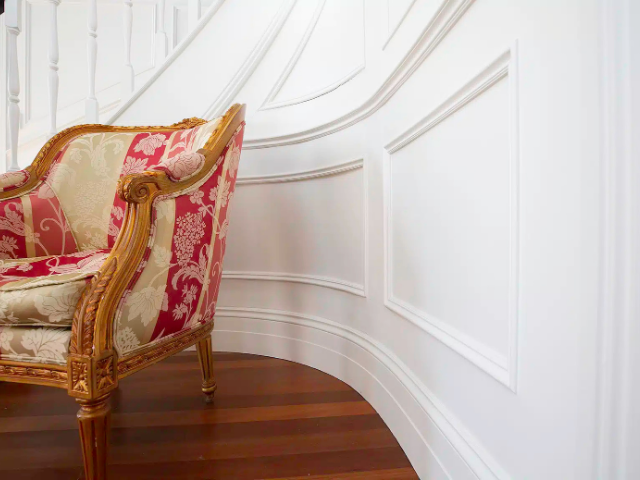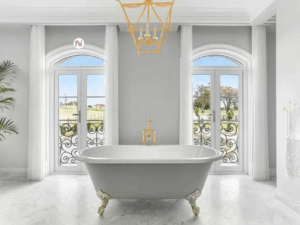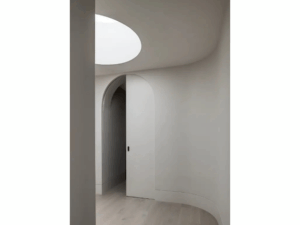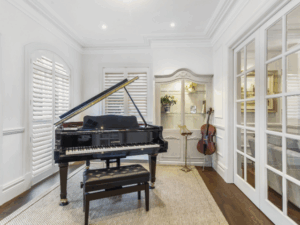Complete Guide to Curved Mouldings for Sophisticated Interiors
Curves are leading the way in interior design. Their soft, organic forms bring comfort, flow, and calm to various interior styles – from grand French Provincial homes to minimalist, contemporary spaces. Yet beyond the furniture and lighting trends lies the unsung hero of graceful curvature: premium timber mouldings.
Engineered for flexibility, curved timber mouldings in Australia — including curved architraves, concave mouldings, and curved skirting boards — are the perfect solution for elevating complex spaces. Whether framing dramatic archways, accenting feature windows, or enhancing curved staircases, custom curved skirting and architraves add both craftsmanship and continuity to any interior. Intrim, can create bespoke curved mouldings that bring your design vision to reality. This guide will provide you with the information you need to specify mouldings on curved surfaces for your next project, from French Provincial manors to modern luxury apartments.

What are curved mouldings and where are they used?
Curved timber mouldings are specially constructed trims designed for use in curved spaces. This curved effect can be created in several ways:
- Using flexible polyurethane material
- Kerfing MDF to increase pliability
- Applying concave panelling to curved spaces
Unlike standard profiles, which are predominantly straight, angular, or flat, Intrim’s flexible curved skirting boards and custom-made curved architraves are tailored to create smooth, flowing transitions in rounded spaces.
Both practical and aesthetically appealing, curved mouldings can accentuate architectural features or expertly conceal joints. The most common applications of curved mouldings are:
- Staircases and balustrades – ideal for following the natural sweep of stairways and handrails
- Entryways and hallways – perfect for emphasising elliptical arches to create inviting transitions between rooms
- Curved ceilings – beautiful accents to make focal points of barrel-vaulted, tray, or domed ceilings
- Rounded windows – bay window architraves add elegant detailing to feature windows
- Wall panelling – to create seamless continuity and make a feature of curved walls

Types of curved mouldings at Intrim:
At Intrim, they know that no two projects are alike. That’s why they offer a range of different moulding options to help you craft a bespoke, curved finish that truly complements the space. Outlining the three core types of curved Intrim mouldings, their typical applications, and some recent designs to inspire you to get creative with curves.
Curved Architraves
Curved architraves are the perfect choice for accenting windows and arches. Custom-made in-house to your unique specifications, curved window moulding architraves draw the eye towards focal bay windows and feature archways, enhancing architectural features while covering gaps and joints where curved walls meet windows or doorframes.
- Popular Profiles: All architraves can be customised into curved profiles, ideal for matching with skirting to ensure a seamless flow throughout. Some of Intrims favourites are SK1063 architrave or SK945B for French Provincial glamour, and Intrim SK60 curved architrave for Victorian inspired interiors.
- Curved Architrave Inspiration: Arched windows framed with curved archiraves are a key feature in luxury classical homes like this French Provincial Mansion. Designed by Sarah Remaili House of Design and built by Phil Borg at B & C Projects, this magnificent design incorporated Intrim SK961 curved architraves throughout to bring signature French ornateness to stairways, windows, and openings.

Curved Skirting Boards:
Choosing the best skirting board for curved walls takes your interior design to the next level. Perfectly moulding to the natural flow of curved walls, flexible polyurethane skirting board material makes it simple to install skirting to curved walls.
- Popular Profiles: Intrim can manufacture most profiles in a curved design using flexible and durable polyurethane. For modern contemporary interiors Intrim Shadowline® skirting, is manufactured in MDF, can be curved by kerfing. For a more classic style interior choose a detailed profile such as Intrim SK452 skirting board.
- Curved Skirting Inspiration: Inspired by the form, function, and flow of nature, the Willow Residences project, designed by BayleyWard and built by Minicon, exemplifies the effortless beauty and sophistication of curved architecture. Sleek, contemporary, and luxurious, this design uses Intrim Shadowline SK800B curved skirting to emphasise the gentle curves of shared spaces to create a beautiful, continuous flow throughout the building.
Minimum Radius Requirements for Curved Mouldings:
When specifying curved mouldings, it’s important to consider the minimum radius each material can achieve. This ensures a smooth, professional finish and avoids stress or cracking during installation.
Minimum radius by material:
- 18mm polyurethane: minimum radius 400mm
- 24mm polyurethane: minimum radius 500mm
- 2mm MDF: minimum radius 500mm
- 15mm MDF: minimum radius 800mm
- 18mm MDF: minimum radius 1800mm
Flexible polyurethane is ideal for tighter curves, while MDF is best suited to larger, sweeping curves. Always confirm the radius requirements with your supplier to ensure the best result for your project.

Benefits of Curved Mouldings:
Curved mouldings give your design scope and flexibility where traditional, straight profiles won’t work. From sweeping staircases to porthole windows to feature panelling, curved wall moulding enhances interiors in the following ways:
- Emphasises the visual flow between rooms and shared spaces
- Complements existing architectural form
- Gives the illusion of a larger space
- Adds a luxurious, bespoke feel to interiors
Which interior design styles work best with curved architraves?
Characteristically elegant, curved timber mouldings align best with interior design styles that value softness, organic shapes, or refined details. Intrim favourite styles for elevating with curves include:
- French Provincial – this style is all about curvaceous lines and elaborate mouldings to exemplify timeless, lived-in interiors.
- Classic and Neoclassic – curved doorway mouldings and skirting complement the ornate arches and grandeur of Georgian, Edwardian, and Victorian interiors.
- Contemporary/Minimalist – a warmer approach to sleek, clean lines, curved trim enhances the organic comfort of rounded spaces.
- Coastal – curves exemplify the relaxed, natural, and airy aesthetic of coastal interiors, softening the transition between outdoors and in.
Explore Intrim’s most popular styles for inspiration on interior design trends for 2025/2026.
